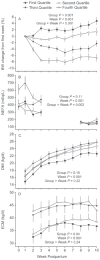Relationships between fertility and postpartum changes in body condition and body weight in lactating dairy cows
- PMID: 24731646
- PMCID: PMC5963276
- DOI: 10.3168/jds.2013-7809
Relationships between fertility and postpartum changes in body condition and body weight in lactating dairy cows
Abstract
The relationship between energy status and fertility in dairy cattle was retrospectively analyzed by comparing fertility with body condition score (BCS) near artificial insemination (AI; experiment 1), early postpartum changes in BCS (experiment 2), and postpartum changes in body weight (BW; experiment 3). To reduce the effect of cyclicity status, all cows were synchronized with Double-Ovsynch protocol before timed AI. In experiment 1, BCS of lactating dairy cows (n = 1,103) was evaluated near AI. Most cows (93%) were cycling at initiation of the breeding Ovsynch protocol (first GnRH injection). A lower percentage pregnant to AI (P/AI) was found in cows with lower (≤ 2.50) versus higher (≥ 2.75) BCS (40.4 vs. 49.2%). In experiment 2, lactating dairy cows on 2 commercial dairies (n = 1,887) were divided by BCS change from calving until the third week postpartum. Overall, P/AI at 70-d pregnancy diagnosis differed dramatically by BCS change and was least for cows that lost BCS, intermediate for cows that maintained BCS, and greatest for cows that gained BCS [22.8% (180/789), 36.0% (243/675), and 78.3% (331/423), respectively]. Surprisingly, a difference existed between farms with BCS change dramatically affecting P/AI on one farm and no effect on the other farm. In experiment 3, lactating dairy cows (n = 71) had BW measured weekly from the first to ninth week postpartum and then had superovulation induced using a modified Double-Ovsynch protocol. Cows were divided into quartiles (Q) by percentage of BW change (Q1 = least change; Q4 = most change) from calving until the third week postpartum. No effect was detected of quartile on number of ovulations, total embryos collected, or percentage of oocytes that were fertilized; however, the percentage of fertilized oocytes that were transferable embryos was greater for cows in Q1, Q2, and Q3 than Q4 (83.8, 75.2, 82.6, and 53.2%, respectively). In addition, percentage of degenerated embryos was least for cows in Q1, Q2, and Q3 and greatest for Q4 (9.6, 14.5, 12.6, and 35.2% respectively). In conclusion, for cows synchronized with a Double-Ovsynch protocol, an effect of low BCS (≤ 2.50) near AI on fertility was detected, but change in BCS during the first 3 wk postpartum had a more profound effect on P/AI to first timed AI. This effect could be partially explained by the reduction in embryo quality and increase in degenerate embryos byd 7 after AI in cows that lost more BW from the first to third week postpartum.
Keywords: body condition score loss; body weight loss; embryo quality; fertility.
Copyright © 2014 American Dairy Science Association. Published by Elsevier Inc. All rights reserved.
Figures




References
-
- Aardema H, Vos PLAM, Lolicato F, Roelen BAJ, Knijn HM, Vaandrager AB, Helms JB, Gadella BM. Oleic acid prevents detrimental effects of saturated fatty acids on bovine oocyte developmental competence. Biol Reprod. 2011;85:62–69. - PubMed
-
- Ayres H, Ferreira RM, Cunha AP, Araujo RR, Wiltbank MC. Double-Ovsynch in high-producing dairy cows: Effects on progesterone concentrations and ovulation to GnRH treatments. Theriogenology. 2013;79:159–164. - PubMed
-
- Bamber RL, Shook GE, Wiltbank MC, Santos JEP, Fricke PM. Genetic parameters for anovulation and pregnancy loss in dairy cattle. J Dairy Sci. 2009;92:5739–5753. - PubMed
-
- Bell AW. Regulation of organic nutrient metabolism during transition from late pregnancy to early lactation. J Anim Sci. 1995;73:2804–2819. - PubMed
-
- Bergfelt DR, Lightfoot KC, Adams GP. Ovarian synchronization following ultrasound-guided transvaginal follicle ablation in heifer. Theriogenology. 1994;42:895–907. - PubMed
Publication types
MeSH terms
Substances
Grants and funding
LinkOut - more resources
Full Text Sources
Other Literature Sources
Medical

